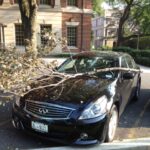So, we could run, but could not hide. A few weeks ago, when Washington was devastated by powerful storms, our family was on vacation at the New Jersey shore. It was very hot, but we never saw a raindrop. And, miraculously our block was spared any damage, so when we got home, everything was in order. On top of that we were certainly aware of the potential for damage, given the Lombardi S level flooding that had occurred.
We felt very lucky – until last Tuesday. After all the storms we have had, there was a brief thundershower in the late afternoon. I noticed it outside my office window, and thought nothing of it. I left the office at around 6:30 pm and walked to my car in Lot E, and saw a tree branch on my car. Figuring it had blown down during the shower, I went to brush it off the hood of my car. But, to my dismay I noted that the windshield had been demolished by the branch, with a nine-iron divot taken out right in the driver’s line of sight. Believe me, the branch wasn’t all that big, but it must have hit the windshield with enormous force — and it damaged the hood as well (see picture below). I am grateful that I wasn’t in the car, or driving when it happened.
My car will be in the shop for about two weeks, and I expect it will make a speedy recovery. That’s the one good thing about auto damage. If nobody is hurt, a full recovery is likely, though it may cost some money. And if the car can’t be fixed, your insurance will usually pay for you to get a replacement fairly quickly and painlessly. If only the same were true for our patients!
People sometimes view health care the same way we view auto repair. Why can’t doctors have the diagnostics and spare parts that are needed, and why aren’t there guys like the ones on NPR’s ‘Car Talk’ who can remotely hear a few descriptive lines about a problem and humorously provide an accurate diagnosis and a prescription for action with apparent infallibility?
I guess this is the difference between professions based in engineering from those based in biology. Biology imposes so many variations, and so much is remains unknown. However, we continue to make progress in closing that knowledge gap, and with every scientific breakthrough we get closer to the level of accuracy we desire. (For example, among other recent successes, both Dick Schlegel and Leena Clarke had good news in the past couple of weeks regarding manuscripts they submitted to high-impact journals.)
I hope you stay dry and safe this week, and get good news about your papers too. And don’t park under a tree!
